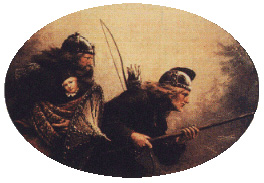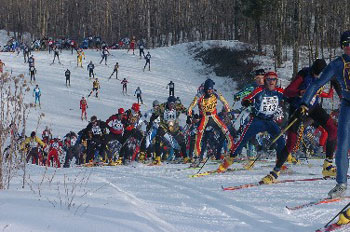
Origins of the American Birkebeiner
Sat, Dec 3, 2005 - By Ernie Burmbaugh
“The year was 1206, was a little Norwegian Prince
Cross the mountains and through the trees
Carried that baby on wooden skis
Civil War runnin’ wild
So the Birkebeiners saved that child
For 55 Kilometers at a fearless pace
They won the first Birkebeiner race”
So begins Lew Orsoni and Eric Schubring’s “The Birkebeiner Rag”, a song about the American Birkebeiner, North America’s premier and largest cross country ski race. This year’s race in the year 2006, the American Birkebeiner will commemorate the 800th year of the legend of King Haakon IV of Norway and his daring rescue by the Birkebeiners. They carried a young child through a winter storm from hostile territory to safety and saved the future King from certain death at the hands of Baglers. The Birkebeinerrennet, a 55 kilometer ski race in Norway, was established in 1922 to commemorate the feat of the Birkebeiners. Running between Rena and Lillehammer, the race requires that each participant carry an 8-kilo weight representing the young prince Haakon. The American Birkebeiner is a 51 kilometer race run between Cable and Hayward, Wisconsin modeled after the Birkebeinerrennet and founded by Tony Wise in 1973. This is the extent of knowledge of most of today’s American Birkebeiner racers and fans about the name of the race on the last Saturday in February.
 At the end of the 12th century, Norway was involved in a series of civil wars caused by vague rules of succession, economic conditions and religious politics. The Birkebeinar Party was one of the combatants. They sought to move the center of political power in Norway back to the traditional north. The Bagli Party represented a more prosperous southern Norway and sought to have it’s own candidates crowned King.
At the end of the 12th century, Norway was involved in a series of civil wars caused by vague rules of succession, economic conditions and religious politics. The Birkebeinar Party was one of the combatants. They sought to move the center of political power in Norway back to the traditional north. The Bagli Party represented a more prosperous southern Norway and sought to have it’s own candidates crowned King.
Haakon’s grandfather, Sverre Sigurdson, a Birkebeiner, claimed to be the illegitimate son of King Sigurd Munn and ascended to the throne in 1177. He did this by organizing the Birkebeinars, a small group of rebels that legend has it had dwindled to about 70 and led them to a successful rebellion. Expanding his influence and fighting with Baglers throughout his reign until his death in 1202, he managed to unite most of Norway. He sired one a son, Haakon Sverreson, with his first wife before she died. He then married, Margareta Eriksdotter, daughter of Eric the Saint, King of Sweden. Her stepson Haakon Sverreson succeeded his father to the throne as King Haakon III in 1202. Haakon III died in 1204, rumored to have been poisoned by his stepmother, Margareta Eriksdottir. He was not married and left no legitimate heirs.
Inga of Varteig, a consort of Haakon III, bore a child after Haakon’s death naming him Haakon Haakonson claiming that Haakon III was his father. She was in hostile territory controlled by the Bagli Party at the time. With no legitimate heirs to the throne the Bagler’s resumed efforts to claim the throne. It would have been advantageous to their cause if young Haakon did not survive.
When the Birkebeinars learned of a Bagler hunt for the young child, they fled with Haakon, setting out for Trondheim, a safe haven in Birkebeinar controlled territory. They encountered a snowstorm and only two soldiers continued on with the boy. They eventually reached safety in territory controlled by the Birkebeinar king, Inge II. Those two Birkebeiners have names, Torstein Skevla and Skjervald Skrukka. It is their feat, skiing through the snow storm and saving the young future King of Norway, that is commemorated each year with a cross country ski race in Norway between Rena and Lillehammer and in Wisconsin between Cable and Hayward.
But that is only part of Haakon’s story, the beginning of a remarkable career. As no direct descendants of Haakon III were known at the time he was succeeded by his four year old nephew Guttorm Sigurdson. The Birkebeiner army at this time was led by Haakon galen (Haakon the Crazy). Guttorm died that same year and another blood relative and Birkebeiner, Inge Baardson was crowned king. When the Birkebeiners learned of Inga’s claim of an illegitimate son of Haakon III, he was placed under the protection of King Inge III. Inge ruled until his death in 1217 coincidentally the same year that the last Bagler king died, Philip Simonson. A regent in the Birkebeiner court, Skule Baardson, negotiated a peace between the two warring parties. Hence, the Prince ascended to the throne in 1217 at a time of relative peace.
In order to prove that her son Haakon was a descendant of Haakon III, Inga was required to undergo “trial by ordeal” in 1218 in Bergen. Her ordeal was, reportedly, carrying red hot iron a specified number of steps. She “bore iron”, in the terminology of the times. The legitimacy of her claim was proven if she completed the task and either received no wounds from the iron or the wounds healed in a reasonable amount of time. Now, this was the Middle Ages and who knows what really took place. In any case, Haakon IV’s reign was legitimized.
The young King would rule Norway until his death in 1263, some 46 years. His reign was not untroubled though as he battled with his mentor Skule Baardsson, married Skule’s daughter in an effort to make pece, and eventually had Skule put to death in 1240 after he led a rebellion against Haakon. For those of you familiar with the sagas, the writer of most of the sagas that have survived to this day, the Icelander Snorri Sturlesson, also died in this rebellion.
King Haakon then ruled a united Norway for the next 23 years. His grandfather, King Sverre Sigurdsson, had been excommunicated in 1194. Haakon’s illegitimate birth prevented his being recognized as King by the Pope until 1247. Haakon brought Greenland and Iceland under Norwegian control. He died of illness in December of 1263 in the Orkney Islands during a campaign to regain control of the Herbrides from Alexander III of Scotland.
His reign, known as the “Golden Age”, expanded Norwegian territory to it’s greatest extent. Under his reign literature and the arts flourished in Bergen, his capital. Norway became in internationally respected kingdom. He began stone construction in Norway and his great hall (Haakonhallen) stills survives in Bergen.
 So when you step into your ski bindings and pull your race bib over your head remember and take inspiration from the events that these Birkebeiner races commemorate. When you come to those last hills before Mary’s field, the lake and Main Street in Hayward, try not to submit to the exhaustion that would have condemned young Haakon to death. View the ladies on “Bitch Hill” as the Valkyeries that pushed Viking warriors to superhuman feats and Valhalla. Push through the pain and deliver yourself to the safety of Birkebeinar territory in Hayward. Eat as many brats at the end of the race as you want or can. Drink a flask of mead and enjoy the festivities of the evening to come. You have won your own Birkebeiner race.
So when you step into your ski bindings and pull your race bib over your head remember and take inspiration from the events that these Birkebeiner races commemorate. When you come to those last hills before Mary’s field, the lake and Main Street in Hayward, try not to submit to the exhaustion that would have condemned young Haakon to death. View the ladies on “Bitch Hill” as the Valkyeries that pushed Viking warriors to superhuman feats and Valhalla. Push through the pain and deliver yourself to the safety of Birkebeinar territory in Hayward. Eat as many brats at the end of the race as you want or can. Drink a flask of mead and enjoy the festivities of the evening to come. You have won your own Birkebeiner race.
I owe most of this research to the website, Wikipedia.org, where you can explore further if you wish. In case you aren’t fluent in Norwegian customs, sons and daughters are named after their fathers. Thus Haakon’s son is Haakonson and Haakon’s daughter is Haakonsdottir. A “double a” or an “a with an o above it” is pronounced as an “o” in Norwegian. Thus, Haakon is pronounced Hokan. Also, since there is no “a with an o above it” on English typewriters it is represented as a “double a”. I am sure, some Norwegian can correct any errors in this tale and I invite them to.
Lastly, the Birkebeinars were one faction in the Civil War. They were so labeled by the Baglers, who sought to discredit them by claiming that they were so poor that they had to wear birch bark shoes. I prefer to think of the Birkebeiners as “birch leggings” as depicted in the piece of art entitled “The Birkebeiners” by Borslein, we all know so well. But, in my mind anyway, the race less about King Haakon IV and more about those two persistent Vikings warriors, Torstein and Skjervald, and their mission accomplished on wooden skis. Every year now, two skiers dress as Birkebeiners and ski the American Birkebeiner. Now you know their names.
If you want to ski the Birkie, visit their website at http://www.birkie.com.
